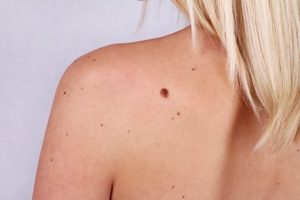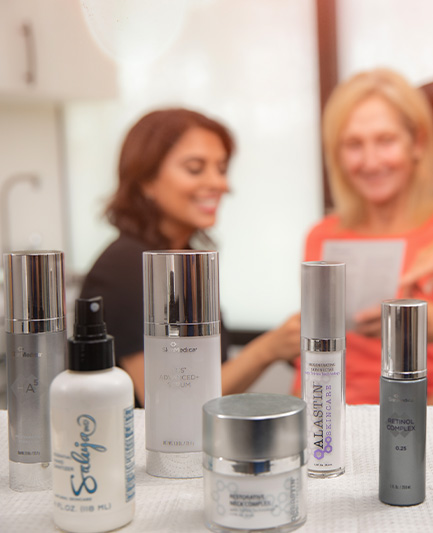SEARCH OUR WEBSITE
You may wish to have a mole removed even if it is not malignant, simply because it causes discomfort or irritation or just because it detracts from your appearance. At Dermatology + Plastic Surgery, led by board-certified dermatologist Anita Saluja, MD and double board-certified plastic surgeon Rebecca Novo, MD, residents of Melbourne, Indialantic, Viera, Brevard County, the beaches, and nearby Central Florida communities can receive mole or skin tag removal treatment and other cosmetic procedures.
What is a Mole?
A mole is a growth on the skin that is usually brown. It can also be flesh-colored and raised. Many raised benign (noncancerous) moles are soft in feeling. Moles may develop anywhere on the skin, and they may appear alone or in groups. Most moles on the body develop in early childhood and moles do continue to appear throughout life. It is normal for someone to have between 10 to 40 moles on their body by the time they reach adulthood. Hairs may occasionally develop in the mole. All of this is quite normal and no cause for alarm.

What causes Moles to develop?
Moles develop naturally when a group of skin cells grows in a cluster instead of spreading out over the skin. These cells are called melanocytes and produce the pigmentation that provides skin with its natural color. Moles may become darker as a consequence of sun exposure, particularly during the teen years and during pregnancy. Family history and genetics also play a role.
Are there different types of Moles on the skin?
Moles that are present at birth are called congenital nevi and are present in about one in 100 infants. These moles have a slightly higher risk of developing into malignant melanoma than moles that appear after birth. Any growth, mole or freckle should be screened for cancer if it has characteristics of the ABCDEs of melanoma.
Skin tags are soft fleshy bumps that tend to develop on the eyelids, along with the neckline, underarm, and inner thigh areas.
Why consider Mole Removal?
Moles may become injured, cause irritation under certain clothing, or simply detract from your appearance. Some patients want to remove moles that are located in a hairy area of the skin because the mole may repeatedly be injured while shaving. Although shaving can irritate a mole, it will not cause the mole to become malignant. Nevertheless, the constant irritation may be annoying, and you may want to have the mole removed. Moles may be removed for simply cosmetic reasons.
How is Mole Removal performed?
A mole may be removed by shaving, snipping, or cutting out the entire spot. Sometimes, the doctors will lightly cauterize the base and edges for optimal outcome. Other times, the doctors will use carefully placed sutures after a deeper removal for optimal closure. The sites usually heal in 7 to 14 days and fade over 6 to 12 months. We recommend medical grade scar gel post procedure for 6 to 12 weeks. Please visit our For Your Best Self-store for our scar gel recommendation.
Click here for additional Scar Reduction Tips.
What is the cost of Mole Removal in Central Florida?
Many health insurance companies will not cover cosmetic or benign mole removal treatment. To help patients manage costs that may not be covered by health insurance, our office proudly provides payment options.
If you want to remove a mole, either for cosmetic reasons or because you are concerned that it may be cancerous, contact Dermatology + Plastic Surgery, led by board-certified dermatologist Anita Saluja, MD and double board-certified plastic surgeon Rebecca Novo, MD serving residents of Melbourne, Indialantic, Viera, Brevard County, the beaches, and nearby communities in Central Florida for information on mole and skin tag removal and other treatments of the skin.
Frequently Asked Questions
Can moles be removed from face without scarring?
How do doctors check if a mole is cancerous?
Are moles genetic?
Can a mole itch and not be cancer?
Can you freeze off a mole at home?
Do moles grow in clusters?
How do you clean a mole that is removed?
Can a dermatologist tell if a mole is cancerous?
Can moles be oval shaped?
Do moles have roots?
How do you get moles?
CREATING LIFELONG RELATIONSHIPS With Our Patients
READ MORE REVIEWSCONTACT US FOR YOUR Customized Consultation
Fill out the form below or call us at (321) 395-3298 to schedule your custom consultation.
OUR BLOG
Learn More
REVEAL YOUR MOST Radiant Skin
Dermatologist Dr. Anita Saluja and plastic surgeon Dr. Rebecca Novo have created an online shop for your convenience. They have curated scientific skin care products that they believe will deliver results: For Your Best Self. And you can always contact our office with any questions.
SHOP OUR SKIN STORE




